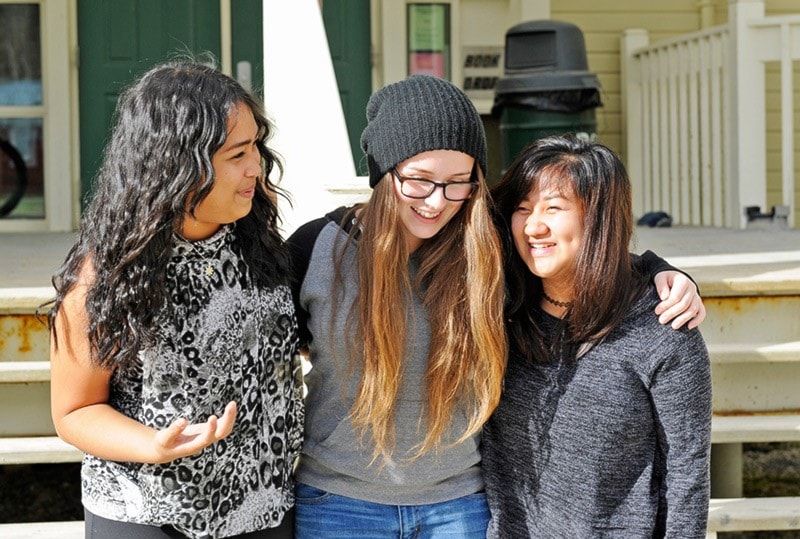In a matter of months, Keisha Panaligan, Aly Soliguen and Nicci Favron will be graduating from high school in Dawson City and going their separate ways.
It’s a scary prospect for the trio, though they still find the days of their Grade 12 year are ticking by too slowly.
But this week, they have a chance to break free of classroom drudgery for a few days and learn some new skills that may serve them after graduation.
Dawson is hosting Yukon Education’s eighth rural experiential model (REM) this week. In total, 84 students from seven communities are meeting in Dawson, where they’ll learn a range of skills, from trapping to 3D printing to hairdressing.
“I like that it’s really focused,” Favron said. “Throughout school, you go to one block for an hour and another block and … you’re not really thinking about one subject for too long. Whereas with REM, you’re like fully immersed in what subject you choose.”
The REM program was launched in 2013 to teach rural Yukon students some hands-on skills and to give them access to activities that aren’t often available in small communities.
Since then, the program has been hosted in Dawson every year, as well as in Carmacks, Watson Lake and Faro.
The number of students participating each year has ranged from about 70 to more than 100, and most receive credit for the courses they take.
Panaligan, Soliguen and Favron have all participated in REM before. Last year, they took part in a course called On the Land, which took them hiking out to Moosehide, a traditional Tr’ondek Hwech’in village site downriver from Dawson. They also went rafting down the Klondike River.
“On our way down, we saw these two moose and they crossed the river right in front of us,” said Soliguen. “That was pretty cool.”
The three break out into giggles when they recall a prolonged, ultimately unsuccessful attempt to light a fire last year. The course was clearly a favourite of theirs.
“It needed a lot of teamwork … because you look out for each other when you go out, check if anyone’s missing, needs help, needs water,” Panaligan said.
This time, they all have different focuses. Panaligan is taking a hair and esthetics course, since she’s thinking about pursuing that in college.
“I want to see if I’m really into it,” she said.
Soliguen is taking a dance and drama program, while Favron is planning to build her own longboard — a type of skateboard — “just because all the past REMs I’ve done, I haven’t got to take something home with me,” she said.
Building a longboard might not seem like an obvious transferable skill. But for instructor Gerry Quarton, it’s a means to an end.
“I’d like students to go into trades, but sometimes popular culture gets them in the door first,” he said.
In the wood shop at the Robert Service School, students will stack longboard-sized strips of plywood with wet glue between the layers. They’ll then place them over moulds on a large table, beneath what looks like thick plastic shrink-wrap. Quarton will then use a large vacuum to suck the air out between the plastic and the table, bending the ends of the plywood over the mould until the glue sets, to get that characteristic longboard shape.
Vernon Asp, the digital media teacher at Tantalus School in Carmacks, will then help the students decorate their longboards with unique First Nations imagery.
“It’s about identity. And teenagers are all about identity,” he said. “And so when they take the board and design it, they can put their own expression into it.”
“It allows them to do something that they probably didn’t think they could do,” Quarton said.
In another part of the school, Mitch Bruce will be running a sort of makerspace for students, teaching them about robotics and 3D printing.
His students will get the chance to build a remote-controlled car and print out pieces of the frame using two 3D printers. They’ll also learn the basics of computer game programming.
Bruce said he’s uploaded a robotics course to the education department’s website so that it can be taught across the territory, even if there aren’t teachers in every school with robotics expertise. He hopes that students will eventually learn programming basics before the REM course, so they can work on more advanced projects when they all get together.
“I absolutely love being here,” he said. “There is no expectation where you’re making (the students) do something. They all want to be here. They all want to learn something.”
For their part, Panaligan, Soliguen and Favron are all getting something a little different out of the courses. Panaligan’s using REM to help her figure out if she wants to go into esthetics next year. Sliguen is taking dance and drama for fun, but said she could become a certified archery coach based on a course she took at the REM in Watson Lake last year.
Favron isn’t necessarily choosing programs with a future career in mind. But she said there are other skills that REM teaches, aside from the official courses.
“I do like how you meet a lot of people here,” she said. “You’re meeting a lot of people and I think that’ll help me in the future, just because you’re put into more social situations where you don’t know people.
“I think that’s a nice skill to have for the future.”
Contact Maura Forrest at maura.forrest@yukon-news.com
